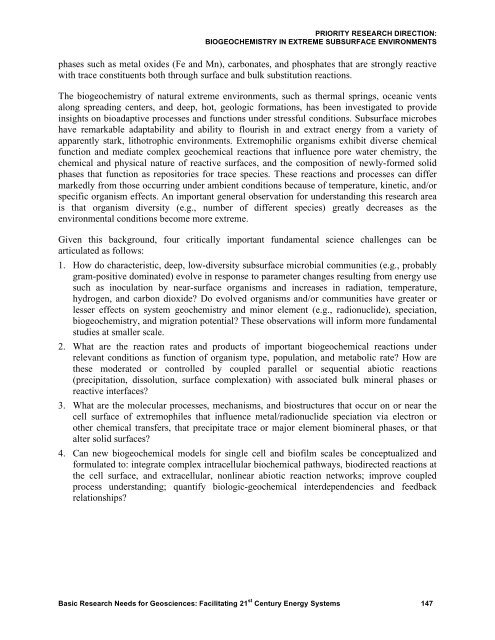Basic Research Needs for Geosciences - Energetics Meetings and ...
Basic Research Needs for Geosciences - Energetics Meetings and ...
Basic Research Needs for Geosciences - Energetics Meetings and ...
- No tags were found...
You also want an ePaper? Increase the reach of your titles
YUMPU automatically turns print PDFs into web optimized ePapers that Google loves.
PRIORITY RESEARCH DIRECTION:BIOGEOCHEMISTRY IN EXTREME SUBSURFACE ENVIRONMENTSphases such as metal oxides (Fe <strong>and</strong> Mn), carbonates, <strong>and</strong> phosphates that are strongly reactivewith trace constituents both through surface <strong>and</strong> bulk substitution reactions.The biogeochemistry of natural extreme environments, such as thermal springs, oceanic ventsalong spreading centers, <strong>and</strong> deep, hot, geologic <strong>for</strong>mations, has been investigated to provideinsights on bioadaptive processes <strong>and</strong> functions under stressful conditions. Subsurface microbeshave remarkable adaptability <strong>and</strong> ability to flourish in <strong>and</strong> extract energy from a variety ofapparently stark, lithotrophic environments. Extremophilic organisms exhibit diverse chemicalfunction <strong>and</strong> mediate complex geochemical reactions that influence pore water chemistry, thechemical <strong>and</strong> physical nature of reactive surfaces, <strong>and</strong> the composition of newly-<strong>for</strong>med solidphases that function as repositories <strong>for</strong> trace species. These reactions <strong>and</strong> processes can differmarkedly from those occurring under ambient conditions because of temperature, kinetic, <strong>and</strong>/orspecific organism effects. An important general observation <strong>for</strong> underst<strong>and</strong>ing this research areais that organism diversity (e.g., number of different species) greatly decreases as theenvironmental conditions become more extreme.Given this background, four critically important fundamental science challenges can bearticulated as follows:1. How do characteristic, deep, low-diversity subsurface microbial communities (e.g., probablygram-positive dominated) evolve in response to parameter changes resulting from energy usesuch as inoculation by near-surface organisms <strong>and</strong> increases in radiation, temperature,hydrogen, <strong>and</strong> carbon dioxide? Do evolved organisms <strong>and</strong>/or communities have greater orlesser effects on system geochemistry <strong>and</strong> minor element (e.g., radionuclide), speciation,biogeochemistry, <strong>and</strong> migration potential? These observations will in<strong>for</strong>m more fundamentalstudies at smaller scale.2. What are the reaction rates <strong>and</strong> products of important biogeochemical reactions underrelevant conditions as function of organism type, population, <strong>and</strong> metabolic rate? How arethese moderated or controlled by coupled parallel or sequential abiotic reactions(precipitation, dissolution, surface complexation) with associated bulk mineral phases orreactive interfaces?3. What are the molecular processes, mechanisms, <strong>and</strong> biostructures that occur on or near thecell surface of extremophiles that influence metal/radionuclide speciation via electron orother chemical transfers, that precipitate trace or major element biomineral phases, or thatalter solid surfaces?4. Can new biogeochemical models <strong>for</strong> single cell <strong>and</strong> biofilm scales be conceptualized <strong>and</strong><strong>for</strong>mulated to: integrate complex intracellular biochemical pathways, biodirected reactions atthe cell surface, <strong>and</strong> extracellular, nonlinear abiotic reaction networks; improve coupledprocess underst<strong>and</strong>ing; quantify biologic-geochemical interdependencies <strong>and</strong> feedbackrelationships?<strong>Basic</strong> <strong>Research</strong> <strong>Needs</strong> <strong>for</strong> <strong>Geosciences</strong>: Facilitating 21 st Century Energy Systems 147
















